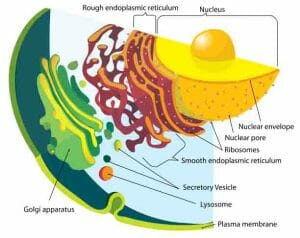Eukaryote Definition
Eukaryotes are organisms whose bodies are made up of eukaryotic cells, such as protists, fungi, plants and animals. Eukaryotic cells are cells that contain a nucleus and organelles, and are enclosed by a plasma membrane. Organisms with eukaryotic cells are grouped into the biological domain Eukaryota (also sometimes called Eukarya). The other two domains of life, Archaea and Bacteria, have prokaryotic cells, which are simpler and lack organelles except for ribosomes, which make proteins.
Types of Eukaryotes
There are four types of eukaryotes: animals, plants, fungi, and protists. Protists are a group of organisms defined as being eukaryotic but not animals, plants, or fungi; this group includes protozoa, slime molds, and some algae. Protists and fungi are usually unicellular, while animals and plants are multicellular. Unicellular eukaryotes can reproduce sexually or asexually. They move with the use of flagella, which are small thread-like appendages that extend from the cell membrane. Unicellular eukaryotes perform many of the same actions as multicellular eukaryotes, such as locomotion, respiration, digestion, excretion, and reproduction.
This picture depicts part of a eukaryotic cell with its enclosed nucleus and various organelles.
Evolution of Eukaryotes
Eukaryotic cells evolved from prokaryotic cells between 1.6 and 2.7 billion years ago. Today, all complex organisms and most multicellular ones are eukaryotes, making this evolution a major event in the history of life on Earth. There are about 75 separate lineages of eukaryotes, most of which evolved into protists. Eukaryotes are more closely related to archaea, unicellular organisms sometimes found in extreme conditions such as hot springs, than to bacteria.
Eukaryotic cells developed specific organelles, which are structures within the cell that perform a specific task. These organelles include mitochondria, which make energy, chloroplasts, which are found in plants and make food from light and carbon dioxide, and the endoplasmic reticulum, which sorts and packages proteins. Some organelles, such as mitochondria and chloroplasts, may have evolved when free-living bacteria were taken up into cells. Under this theory, bacteria and the cells had a symbiotic relationship, where each benefited from the presence of the other. Over time, these bacteria formed the organelles incorporated within eukaryotic cells that are seen today, and became a necessary part of the eukaryotic cell. Mitochondria have DNA that is separate from the chromosomal DNA found in a cell’s nucleus. However, another theory is that small amounts of DNA already in the cell were simply infolded within the cell membrane and evolved into organelles such as mitochondria. Theories involving mitochondria appearing in a cell that was already almost eukaryotic, with a nucleus, are known as autogenous models. Yet another theory proposes that eukaryotic cells evolved when an archaeon and a bacterium merged to form one cell. This is known as a chimeric model.
Some eukaryotes reproduce asexually, while others reproduce sexually. The development of sexual reproduction is another defining feature in the evolution of eukaryotes. It is believed that the common ancestor of all eukaryotes reproduced sexually, and that asexual eukaryotes (such as some amoebas) evolved asexuality from an ancestor that was sexual. Prokaryotes only reproduce asexually; genes can be exchanged between individuals through horizontal gene transfer, but this is not sexual reproduction.
Differences Between Eukaryotes and Prokaryotes
While eukaryotes are complex, usually multicellular organisms that have eukaryotic cells, prokaryotes are usually single-celled organisms that have simpler prokaryotic cells. Eukaryotes include all complex lifeforms including protozoa, plants, fungi, and animals, while prokaryotes are microscopic, mostly single-celled lifeforms, either archaea or bacteria. Eukaryotes’ cells have DNA in a nucleus surrounded by a nuclear envelope, while the cells of prokaryotes do not have a distinct nucleus. Instead, they have a nucleoid, a nucleus-like region where DNA is concentrated. In addition, the DNA of eukaryotes is condensed into structures called chromosomes, which allow for a lot of genetic information to be packed into a small space and are neatly organized when it comes time for the cell to duplicate its DNA and divide. They transmit genes from parents to offspring and, control cellular processes such as metabolism, and allow cell differentiation to take place during development. Eukaryotic cells are usually much larger than prokaryotic cells—they are usually a couple hundred times the size of prokaryotic cells—with a lower metabolic rate and a lower growth rate. An extreme example is found in plasmodial slime molds. These eukaryotes can be up to a meter in length and are a single cell with many nuclei inside.
Related Biology Terms
- Eukaryotic Cell – a cell that has organelles inside it, including a true nucleus surrounded by a nuclear envelope.
- Prokaryote – an organism, such as archaea or bacteria, that has prokaryotic cells.
- Nuclear Envelope – found only in eukaryotic cells, a membrane that separates the nucleus from the cytoplasm (the rest of the cell).
- Mitochondria – an organelle where cellular respiration takes place and energy is produced.
Quiz
1. Which is a theory of the evolution of mitochondria outlined in this article?
A. Free-living bacteria were incorporated into cells.
B. Mitochondria were formed from partial infoldings of the cell membrane.
C. Mitochondria evolved when an archaeon and a bacterium merged.
D. All of the above
2. Which is NOT a characteristic of a eukaryotic cell?
A. A nucleus surrounded by a nuclear envelope
B. The presence of mitochondria
C. DNA organized into chromosomes
D. a nucleoid region where DNA is concentrated
3. Which organism is a eukaryote?
A. Cyanobacteria
B. Human
C. Myxobacteria
D. Archaea

